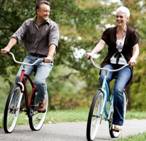Do you remember the Tin Man in the movie The Wizard of Oz? He got caught in a rainstorm and couldn't get to his oil can. Eventually, he rusted up and could hardly move.
People who have arthritis at times feel like the Tin Man.
Osteoarthritis usually affects the weight-bearing joints such as the knees and hips but it can affect any joint. It attacks cartilage, the rubbery tissue that covers the end of your bones and provides cushioning and lubrication.
There are many forms of arthritis. The term, in fact, refers to over 100 different conditions. The word arthritis means inflammation of the joints. All forms of arthritis affect the joints and other connective tissues in the body, such as ligaments and tendons. Arthritis affects an estimated 40 million Americans, the majority of them suffering from osteoarthritis. Other common types of arthritis are rheumatoid arthritis, gout, bursitis, tendonitis and fibromyalagia.
When people say arthritis, they are usually referring to osteoarthritis. In this article, we will focus on the causes, symptoms and treatment of osteoarthritis. If you, or someone in your family has osteoarthritis, you certainly do not have to feel like the Tin Man. If you take care of yourself and receive the correct medical treatment and advice you need, you can lead an active and healthy life.
The following questions and answers about osteoarthritis are based on an interview with Professor Jacob Menchell, a specialist in internal medicine, geriatric medicine and metabolic bone disease.
Osteoarthritis is characterized by pain, stiffness and swelling in the affected joint.
Those who work in occupations that require a great deal of physical exertion, such as construction workers, are at a higher risk of developing osteoarthritis at a relatively young age. People who are overweight may also develop it early on.
- Anti-inflammatory drugs: These are painkillers such as acetaminophen, aspirin or ibuprofen. Another group of drugs that is prescribed is known as NSAID, non-steroid anti-inflammatory drugs. A number of new and effective NSAID drugs have recently been developed to relieve the pain of arthritis. Sometimes, they create stomach problems, like ulcers and the patient must be under medical surveillance. If the arthritis persists, and other drugs are not effective, steroids might be used. There are many types of steroids and they might be given in low dosage. But there are many side effects associated with steroids, and must be closely monitored.
- Physical therapy: A professional physical therapist can work with you to strengthen the muscles around the joints and to prevent restrictions of mobility. Your physical therapist can teach you exercises to do at home. She may also use hydrotherapy, a treatment using a heated pool or whirlpool. (You can try giving yourself hot or cold treatments at home too.) In addition to physical therapy, it is important to exercise your muscles and joints by walking. Swimming is also an excellent exercise. You may want to join a class where you will do gentle stretching exercises. The point is to exercise your joints without straining them.
- Surgery: In some cases, a person with osteoarthritis tries many treatments to relieve pain and nothing appears to work. Your joints may be damaged badly. Your doctor may suggest joint replacement surgery, or arthoplasty. In this operation the surgeon replaces the diseased or damaged bone with a synthetic substitute. Undergoing surgery may seem overwhelming, but the truth is that a hip or knee joint replacement can give you a new lease on life. About 150,000 people a year have hip replacement operations. This is the most common type of joint replacement. Arthroscopy is a new type of surgery, where an incision is made and a lighted tube is put into the joint, to examine it, and clean out some cartilage fragments causing inflammation.
- Natural treatments such as spas and mineral baths can relieve pain and give you a sense of well being. The same is true for reflexology and various forms of massage therapies. If one of these treatments work for you, great! But please be wary of unusual treatments that promise miraculous results.
Exercising regularly helps strengthen muscles and joints. But certain types of exercise are better than others. For example, jogging is more strenuous than walking, and joggers may develop osteoarthritis earlier.
Helpful Websites
- Intelihealth: John Hopkins University's excellent health site. In the Senior Health section there is a clearly written and informative on-line book about arthritis.
- The Arthritis Foundation: In addition to helpful answers to your questions, the Arthritis Foundation has chapters and activities around the U.S. You can also order books or pamphlets about arthritis. Some of the pamphlets are free.



